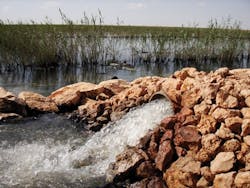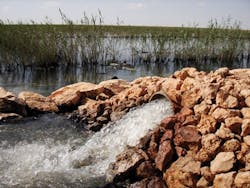By Mitchell Stocki
In October 2011, Native Lands Environmental & Prince Contracting faced the difficult challenge of dewatering an entire lake in order to build a new bypass road extension in Sarasota, FL. The new Exit 213 required the complete dewatering of one lake while discharging the water into an adjacent waterbody recognized as a world class rowing lake in pristine condition.
Approximately 25 million gallons of water had to be removed for construction. To complicate matters, road construction operations had disturbed 90% of the soil around the soon-to-be-dewatered lake, making any significant rain event more challenging by adding to the already high levels of turbidity. Sediment control was a major concern.
Project engineers sought to find a reliable and cost-effective solution that would reduce turbidity and eliminate any chance of bio-accumulation that could potentially be toxic to the lake fish. After meeting with engineers and inspectors from Southwest Florida Stormwater management, as well as with Prince Contracting and Wilbur Smith & Associates, it was concluded that the HaloKlear dual biopolymer system could address the challenges.
The dual biopolymer system uses chitosan-based flocculent to trap hydrocarbons, metals and nutrients. It works on virtually any soil type and a wide range of pH levels, and the natural biopolymers are 100% biodegradable.
Getting Started
At the project site, initial influent Nephelometric Turbidity Units (NTUs) measured between 172 and 846. Per Florida regulations, effluent levels may not exceed 29 NTUs over background. At this site, background was 3 NTUs; therefore, discharge could not exceed 32 NTUs.
Tests were conducted to determine the appropriate dose of polymer. Because of the changing conditions of the soil to the dewatering area, the system's onsite jar test kits and calculator provided an extra value to the contractor by providing an immediate dose response. This made it possible to quickly make adjustments to optimize dose and eliminated the expense and hassle of sending samples off to outside labs.
Once the tests were completed, a simple manifold kit was built to house the dual biopolymer socks. (see Fig. 1). Turbid water is directed through the system under gravitational flow to a sediment basin system, in this case, sediment bags.
To aid in the settling process and reduce costs of additional sediment bags, a 3,000 gallon weir tank was brought in and retrofitted to accommodate a 600 gpm flow rate.
Daily operations consisted of adding fill dirt to the lake perimeter, slowing the reduction of the lake's footprint until it was entirely filled in. Part of the 'filling in' of the lake was accomplished by adding rich organic loam, high in tannic acid. This made settling of the turbidity even more challenging since loam mixed with polymers will float.
Because of the high organic content and the weir tanks inability to settle all material, sediment bags were deployed to capture any excess material that would have escaped (see Fig. 2). Sediment bags also aid in filtering suspended fine particles in the water column adding increased water quality.
In order to help satisfy concerns by regulators, extensive monitoring was conducted. Residual polymer tests were initially done hourly on water coming off the sediment bags as well as from the end of the discharge to ensure there was no bio-accumulation. With the system's biopolymer test kit, the presence of free residual biopolymer could be detected on-site, before it could even leave the jobsite. This ensured the contractor was compliant with local and federal discharge regulations without having to depend on an outside lab.
All data was provided to regulators as a part of the monitoring process.
Because of fluctuating NTU levels ranging from 172 to 746, NTU samples were taken every half hour to satisfy regulatory monitoring logs. Residual tests eventually decreased to every three hours.
After approximately 15 hours of pumping, NTU readings averaged between 2.85 and 12.0. Sediment bags and dual biopolymer socks were changed once at 15 hours of use, treating approximately 540,000 gallons.
In addition to cleaning stormwater to well within the regulated discharge limits, implementation of the dual biopolymer system led to considerable savings for the contractor by reducing overall stormwater management costs (see Fig. 3).
Stage Two
Although the dual polymer system was successfully treating a large volume of water using the weir tank and sediment bags for capture, the massive scale of the project and recent tropical rains presented some added challenges. The contractor needed to find a means to reduce project costs and keep operations on schedule.
In early November 2011, project engineers tested some changes to the treatment train to make it a more passive process. They ultimately removed the 3,000 gallon weir tank, eliminating the cost associated with its rental. They also eliminated the two 15' x 15' sediment bags used for sediment capture, cutting the cost of them ($250.00 per day) as well as the manpower needed to monitor them.
A 60' x 8' rock channel was constructed, with check dams placed apart in approximately 20-foot sections (see Fig. 4). The channel was lined with course filtration media called Excelsior Blankets to further clarify the effluent water. This satisfied the contractor's desire to pump a larger volume of water (900 – 1100 gpm) by dissipating the effluent output and creating a small settling pool.
Moving to the more passive model also gave the contractor the flexibility to pump twenty-four hours rather than eight.
By February 2012, the entire lake had been successfully dewatered so that construction of the bypass road could continue. Small dewatering operations will continue as rain events occur.
By using the dual biopolymer system, project engineers were able to solve the sediment control challenges of the construction site while simultaneously controlling costs, meeting environmental regulations, and ensuring clean, clear water was discharged from the site.
About the Author: Mitchell Stocki is currently the Market Development Manager for HaloKlear, covering the Eastern United States. He previously worked as the Regional Operations Manager and project consultant for ACF Environmental, the largest distributor of environmental products for the construction industry. Mitchell is a graduate of La Salle Military Academy, R.O.T.C.
More WaterWorld Current Issue Articles
More WaterWorld Archives Issue Articles





